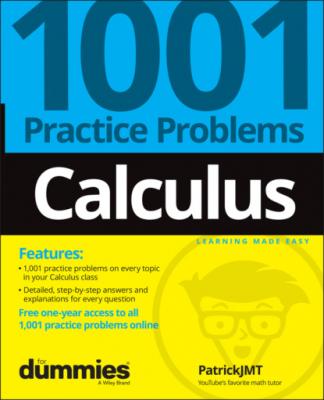Calculus: 1001 Practice Problems For Dummies (+ Free Online Practice). Patrick Jones
Чтение книги онлайн.
Читать онлайн книгу Calculus: 1001 Practice Problems For Dummies (+ Free Online Practice) - Patrick Jones страница 27
 finding derivatives.
finding derivatives.
The Problems You’ll Work On
In this chapter, you use implicit differentiation to
Find the first derivative and second derivative of an implicit function
Find slopes of tangent lines at given points
Find equations of tangent lines at given points
What to Watch Out For
Lots of numbers and variables are floating around in these examples, so don’t lose your way:
Don’t forget to multiply by dy/dx at the appropriate moment! If you aren’t getting the correct solution, look for this mistake.
After finding the second derivative of an implicitly defined function, substitute in the first derivative in order to write the second derivative in terms of x and y.
When you substitute the first derivative into the second derivative, be prepared to further simplify.
Using Implicit Differentiation to Find a Derivative
408–413 Use implicit differentiation to find
408.
409.
410.
411.
412.
413.
Using Implicit Differentiation to Find a Second Derivative
414–417 Use implicit differentiation to find
414.
415.
416.
417.
Finding Equations of Tangent Lines Using Implicit Differentiation
418–422 Find the equation of the tangent line at the indicated point.
418.
419.
420.
421.
422.
Chapter 8
Applications of Derivatives
What good are derivatives if you can’t do anything useful with them? Well, don’t worry! There are tons and tons of useful applications involving derivatives. This chapter illustrates how calculus can help solve a variety of practical problems, including finding maximum and minimum values of functions, approximating roots of equations, and finding the velocity and acceleration of an object, just to name a few. Without calculus, many of these problems would be very difficult indeed!
The Problems You’ll Work On
This chapter has a variety of applications of derivatives, including
Approximating values of a function using linearization
Approximating roots of equations using Newton’s method
Finding the optimal solution to a problem by finding a maximum or minimum value
Determining how quantities vary in relation to each other
Locating absolute and local maxima and minima
Finding the instantaneous velocity and acceleration of an object
Using Rolle’s theorem and the mean value theorem
What to Watch Out For
This chapter presents a variety of applications and word problems, and you may have to be a bit creative when setting up some of the problems. Here are some tips:
Think about what your variables represent in the optimization and related-rates problems; if you can’t explain what they represent, start over!
You’ll have to produce equations in the related-rates and optimization problems. Getting started is often the most difficult part, so just dive in and try different things.
Remember that linearization is just a fancy way of saying “tangent line.”
Although things should be set up nicely in most of the problems, note that Newton’s method doesn’t always work; its success depends on your starting value.
Finding